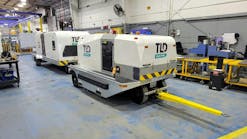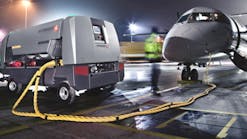It takes a crisis to start the little gray cells working. When fuel was 25 cents a gallon, we taxied airplanes around with abandon. Airport and airways congestion meant long lines of jets waiting their turn to take off, trails of heat shimmering behind each one and haze forming into dense clouds of smog. One of the sights at JFK was the occasion for ultimate horror — a change of runways. This could be caused by a radical shift in the winds or by changes in air traffic, mandating a different direction for traffic flow. You would see the jets form up into a long line, much like the elephants at Barnum and Bailey's Circus, lacking only a trunk to grab the tail of the aircraft in front. Thirty or more big jets were in a row. They would trundle the long miles to the new hold areas, and one could imagine the cursing from passengers and especially the crews.
That condition became somewhat alleviated by gate holds. Why start four thirsty engines, taxi out and hold, creeping up yard-by-yard as the successive No. 1s roared down the runway until finally your turn came. The problem, though, was that there was not an infinite supply of gates. A departure not departing meant an arrival could not arrive. So often arrivals held, and held and held. The frustration for the passengers was that they had indeed arrived but could not debark, and if there was a connection to be made ... well. Meanwhile, too, there were still big engines running and waiting for the chance to move the aircraft that last few hundred yards into the gate. Snow or thunderstorms only aggravated the problem. The feds regulated this waiting, threatening huge fines against the airline who dared hold their passengers captive for more than a specified number of hours. Good thought but the airlines instead began canceling flights rather than risk a long ground hold, and, "We are sorry, but there are no seats available until next Tuesday," for the stranded traveler.
Aircraft Towing a Solution?
Well no answers so far for the problems of traffic density. The promise of a new and improved air traffic control system has been dangled for years, always coming soon but not just now. But we are once again re-examining an old idea. Why have aircraft taxied under the impulse of the wasteful and thirsty power of their own turbine engines? Why not tow them out to the runway, only starting their main engines minutes before their takeoff? A thrifty high-efficiency diesel certainly would burn a lot less fuel than the aircraft's own main engines in traversing the miles from terminal to gate. And we could meet inbounds in the same way, towing them from runway to gate.
It certainly is more practical than it once was where a small crew was required to hook up a towbar to the nosegear and attach the tow tractor. Now, towbarkless tugs have scoops for nose gears or grippers and grabbers that can couple the tow vehicle to the aircraft quickly and easily. Of course, there are some practical problems that must be faced. The need for dedicated roads for tow vehicles to get to and from runways, and the potential for inadvertent runway incursions by tow vehicles come to mind immediately. GPS navigation would have to be fitted into the tug. It is one thing to taxi an aircraft from the cockpit 15 feet or more up, and quite another to be four feet off the ground inside a tug and trying to find your way at night in a fog. I have been out there under emergency conditions trying to find my way around, and it is frightening. Training for the ground crew in moving and navigating around active runways and taxiways will be paramount, as there is a huge potential for the already-mentioned runway incursions. Then there will be the added burden on the ground controllers, already maxed out in handling the aircraft flow and now having to handle the additional burden of lumbering tugs intruding where only aircraft dared go.
There are certainly added benefits to towing aircraft to and from runways and terminals aside from the obvious saving in Jet A. There will a definite reduction in aircraft noise, ground vehicles being a lot quieter than aircraft turbines. There are political consequences, too. I became maintenance manager at an airport that had a vocal residential community located just across an open body of water from my airline's terminal. On turning into the gates, the jet nozzles pointed directly at them. There was no doubt that the noise of our jets taxiing in and out of the gates carried across to them Their town council and their state representatives proposed some Draconian legislation mandating that we would have to tow all aircraft in and out of the terminal and part way to the runway. Because of the layout of the ramps, the other airline's terminals were around a corner and so their noise did not impinge on the community. Only my airline would have been so affected. There were some intense negotiations and lobbying and ultimately the legislation was dropped just shortly before I transferred there. I was pleased to find I had just had a new office clerk added to my staff, as did several other departments in the airline. This was in spite of a hiring freeze that was being rigidly enforced. I was less pleased to find that attendance was not rigorously kept on these folks, nor was there any need to hold them to regular hours. There were also familial blood ties between them and some of the state legislators and town councilmen. No doubt it was completely coincidental. I finally lost the clerk when she decided that it was more pleasant to work at the race track than around a grubby maintenance department. And so it goes in some communities. Noise abatement can take many forms.
I also note that Airbus is investigating installation of drive motors in aircraft landing gear so that the pilots could motor out or in on aux power without use of the main engines. An intriguing concept for sure, but doubtful that it will pay to burn fuel on every flight to haul around a considerable mass of motors and electric cables in order to save fuel by not taxiing under main engine power.
No doubt GSE manufacturers will benefit from a move to more towing. They will, however, gain a lot if they can prevail on the aircraft manufacturers to get a more universal and standardized means of attaching tugs to aircraft. Then too decisions will have to be made as to who steers and controls the joined vehicles. Fifty years ago AMF produced a unit that coupled to the main gear and actually drove a pair of aircraft wheels. It could reach impressive speeds and was controlled by the aircraft captain using a remote box on the end of a long cable. Many aircraft nowadays have no opening cockpit windows so that concept of passing up a cable and control box would have to be revisited. But with the price of fuel only trending upward, it will pay for GSE companies to apply their little gray cells.




